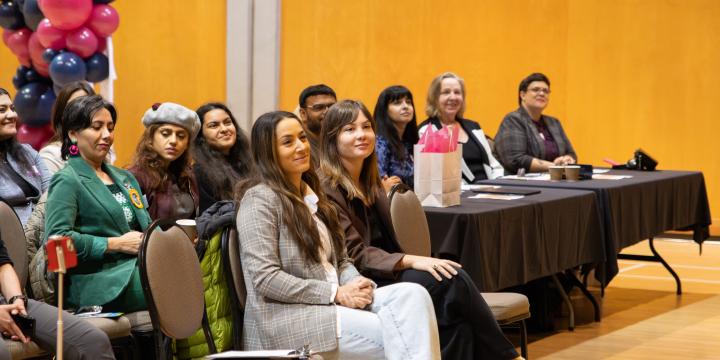
Does the word networking cause you to break out into a cold sweat or make you want to run and hide? You are not alone. Why not reframe the entire concept of networking and use semantics to your advantage? Instead of the term networking, we'll refer to it as chatting with people. That is really what networking is, chatting, and it can take place in many contexts: over coffee, in line at the grocery store, online on a social media site, or in a formal setting at a business event. Any place, any time.
We’ve already established what networking is (chatting with people) but why should we network?
Control & Targeting
A common frustration for many job seekers is the lack of control they have over the process of job searching. And fair enough. If you’ll be spending 8 hours a day in a job, you really ought to have more say over the process. By targeting a specific company, industry or job type, you can uncover valuable information that will help you take more proactive and efficient steps towards employment. This will allow you to pinpoint a direction and take your job search approach from quantity with no direction, to quality-based and focused.
Professional Development and Maintenance
Pre-employment networking, sorry, chatting with people, is not only a great way to uncover really great information, but it also has the added benefit of, wait for it, expanding your network! This network can continue with you as you move through your professional career, so take the time to nurture the relationship through sharing of ideas, introducing people and connecting through social media sites, such as LinkedIn.
Networking 101 – Let’s move into the how of networking
Who do you know?
Take an inventory of your current network. This consists of your family, friends, neighbours, and previous colleagues, including your references. From there, you can expand your network by joining associations or like-minded groups (in person or online).
Give back
Why not fill a gap on your resume and give back to the community through volunteering? This is a fantastic way to expand your network while also learning something new.
Learn!
Taking a course or workshop is a really great way to expand your knowledge and your contact list! Have a look at your local college or community centre for free or low-cost workshops or courses. Universities will often have courses open to the public. Be careful here, though. Learning is very, very contagious!
Formal Meet ‘n Greets
There are formal networking events you can participate in within your own community. Local chambers of commerce and business associations will often host networking events. Commonly, they come in two forms: a sit-down, meal-type event or a more casual ‘business after 5’ event.
For the more novice networker, I might suggest the sit down meal-type because it allows for a more natural conversation within a confined area (a breakfast or dinner table), rather than having to approach a group, with a drink in hand, in mid-conversation.
“Hello, nice to meet you! What do you do?”
Yes, you will most likely be asked this question within the first 10 seconds of meeting someone. How do you answer it when what you are currently doing is job searching? First, establish who your audience is to determine what you say and how you say it. Are you in a casual setting at a party? Talking to a family friend? Taking a course? Or trying your hand at a business after 5 networking event? This matters. Tailor your communication style and what you talk about according to your audience. You wouldn’t exactly open up to potential employers the way you might to a long-time family friend, right?
Once you have established your audience, tell them what you have done (for example, a previous position held) and explain the tasks you enjoyed about it: “Until recently, I was a technical CSR for a software company. I really enjoyed working directly with clients and troubleshooting their IT issues.” Next, tell them the direction you would like to go: “I’m looking to move into a role that has more direct client contact, where I provide onsite technical training.”
Less is more. If you go beyond 30 seconds here, you could lose your audience. Again, consider who is listening. You’ll then want to finish with a call to action that is appropriate for that listener: “I noticed that you are with Hootsuite, would you recommend anyone over there that I can chat with to get more information about their training department?”
Chatting 101 – Consider these tips
Keep your listener engaged. Smile while you are talking about what you like to do. Maintain eye contact. If they start to look away, consider asking them a question about themselves to bring them back to you and your conversation.
Body language shouts. In addition to eye contact, be aware of your non-verbal tone. Use your hands while talking (not overly); keep your shoulders straight to portray confidence, and lean in a bit when they talk to you.
Return the conversation. As mentioned above, be sure to ask them questions as well. You may be able to use this information to offer tips or suggestions of your own. For example, they might tell you that they are a Hootsuite employee, but then disclose that their real passion is baking. It just so happens that your neighbour owns a very successful patisserie. Hey, it can happen. It does happen!
Social Networking
Social networking sites, such as LinkedIn, Twitter and Facebook are invaluable resources for networking. Because there are so many distractors, however, the tricky part is to stay focused. Prior to opening up any accounts (or posting on your current accounts), ask yourself the following:
- Who do I want my audience to be?
- Who will I be? Odd question, I know, but will you be a ‘job seeker’ or will you be a source of information for your field? Who will you be?
- Do I understand the tools available with each platform I am using? Do I know how to get the best out of each tool?
To ensure you get what you need out of each site, have a look at some online ‘how to’s’ for using social media. The tips available will help give you a starting point. Your community may also offer some free or low-cost workshops on using social networking sites for job search.
When you are ready to open the account, or dust off the current one, include a clear, current photo (for sites that have photos as part of your profile), and be sure to include a brief headline that best describes your professional self.
Finally, consider this rule when it comes to online networking: for every time you take, give back 3 times. Taking might involve posting a question about the best courses to take for a particular job. Giving back could include commenting on others’ articles or blog posts, offering to do an e-introduction for two people or simply ‘liking’ someone’s post. Whenever you see an opportunity to give on social media, do it.
Networking can be done at your discretion. You can start off slow (online) and then move from there (in-person events). Remember that you can also be a valuable resource for someone, so be generous with your own network. The key is to be clear about your needs, and what it is you are looking to do because if people know how they can help you, and they can, they will. That is the beauty of networking.
Chantal Rackley is a Certified Career Development Practitioner (CCDP) and a program manager at the YWCA.
For free employment programs and all things job search-related, visit our Help for Job Seekers page.

